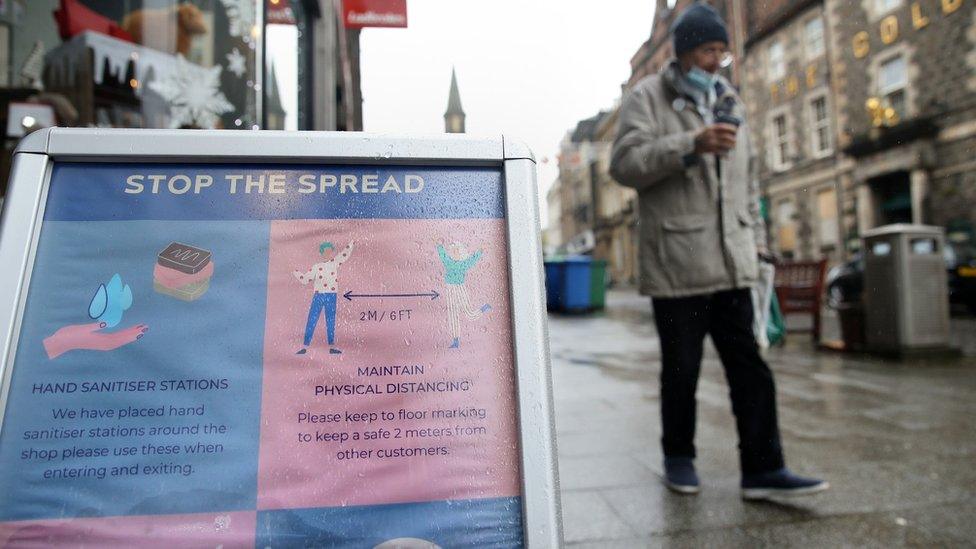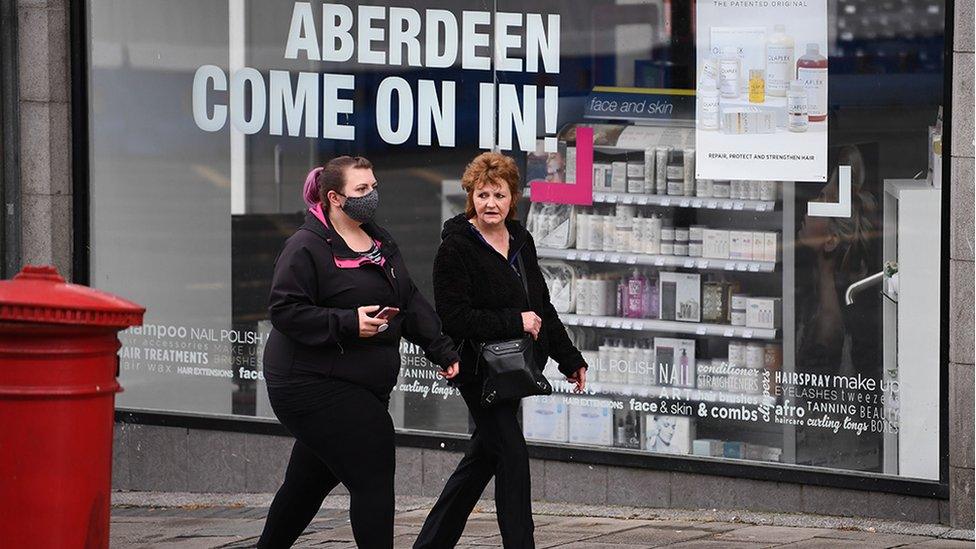Covid in Scotland: No change to virus alert levels
- Published
- comments

No changes have been made to Scotland's Covid-19 alert levels.
First Minister Nicola Sturgeon said 11 areas would remain in level four, which has the harshest restrictions, until 11 December.
There had been speculation that Aberdeen and Aberdeenshire could move to level three after a rise in cases.
Ms Sturgeon said they would stay in level two for now, but the government would "look carefully" at the data in the next few days.
The first minister said that current measures were having a "positive impact" across Scotland and that the average number of daily cases was falling.
The latest figures showed that a further 754 people had tested positive for Covid-19 and 34 more deaths had been registered, taking the total under that measure to 3,759.
Ms Sturgeon said independent estimates suggested that Scotland's R number - the rate of virus reproduction - was slightly below one, and the country was "in a position where infections are declining".
However, she added: "The level of the virus overall is still higher than we need it to be."
The first minister warned that an increase in cases over winter could "quickly intensify" pressure on the NHS.
"Although we are encouraged by the impact current restrictions have had, the need to strengthen and solidify that progress means that we need to continue to take care and err on the side of caution," she said.

Each council's position in the five-level system is reviewed every Tuesday.
Ms Sturgeon said restrictions would be lifted on areas in level four on 11 December, and that next week's review would be "more substantial".
Public health officials had recommended Aberdeen and Aberdeenshire should move up to level three, although council leaders had lobbied for them to remain in level two due to the risk of "economic harm" .
Ms Sturgeon said the government would "continue to look carefully" at both areas.
She pointed out that cases had "increased sharply" in the last week, rising by 68% in Aberdeen and 42% in Aberdeenshire. While they are still below the national average, the figures are higher than some level three areas.

"However, there is a need to understand more deeply the extent to which these increases are driven by specific outbreaks that are being actively managed, within for example food processing and care settings, versus a wider and more general rise in community transmission, which would obviously be a concern - especially as we go further into winter," said Ms Sturgeon.
She said the data would be considered in more depth over the coming days before reaching a conclusion.
An investigation has been launched into Covid cases linked to an Aberdeenshire food plant.
Ms Sturgeon had previously said she was "hopeful" Dumfries and Galloway could drop to level one.
She said this change could happen "very soon" but winter factors and the area's proximity to councils with high infection rates had to be considered.
"That is why the strong public health advice - which the Cabinet has accepted - is for it to remain in level two for now," she said.
South Scotland Labour MSP Colin Smyth said the decision was "completely unacceptable" and would have "a devastating impact on local businesses".

Which level is your area in?
Level four - East Ayrshire, East Dunbartonshire, East Renfrewshire, Glasgow, North Lanarkshire, Renfrewshire, South Ayrshire, South Lanarkshire, Stirling, West Dunbartonshire, West Lothian.
Level three - Angus, Clackmannanshire, Dundee, Edinburgh, Falkirk, Fife, Inverclyde, Midlothian, North Ayrshire, Perth & Kinross.
Level two - Aberdeen, Aberdeenshire, Argyll & Bute, Borders, Dumfries & Galloway, East Lothian.
Level one - Highland, Moray, Orkney, Shetland, Western Isles.

